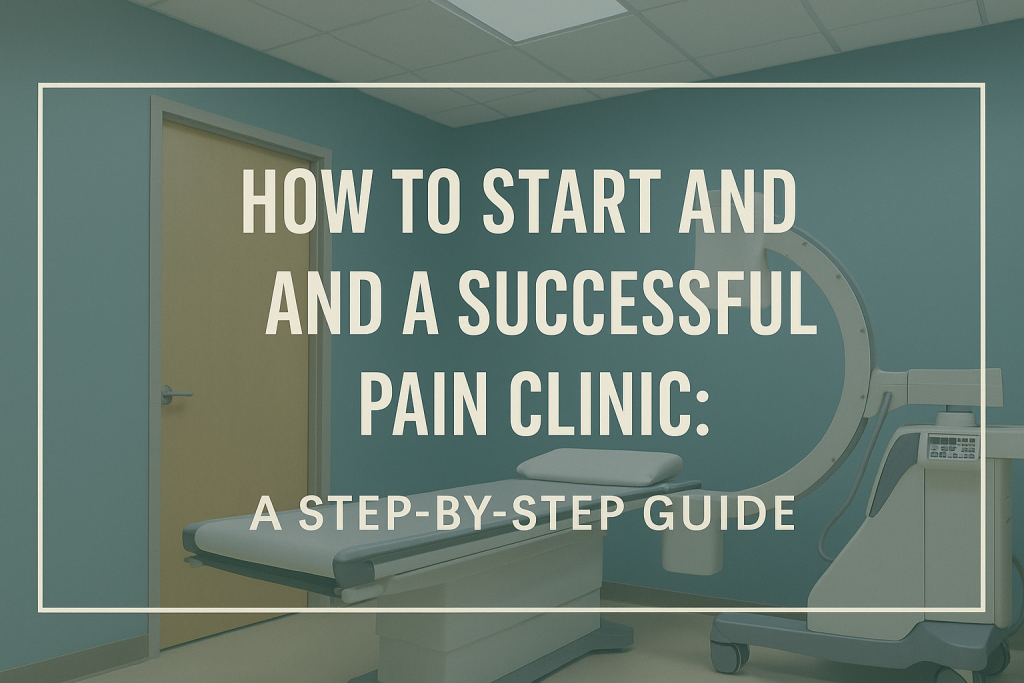Introduction
Chronic pain affects millions globally, yet access to comprehensive pain management remains limited in many regions. If you’re a healthcare professional driven to fill this gap, starting a dedicated pain clinic can be both a rewarding and impactful journey. But establishing a successful pain clinic involves much more than just securing space and equipment—it requires structured planning, proper training, and a deep understanding of pain medicine.
In this article, we break down the essential steps to help you start and run your own pain clinic. Whether you’re just beginning or seeking to enhance your existing setup, this guide will serve as your roadmap.
1. Set Up the Infrastructure: Location, Layout, and Logistics
Start by selecting a suitable location—preferably accessible, quiet, and compliant with medical zoning laws. Your clinic should have:
- Reception and waiting area
- Consultation and procedure rooms
- Recovery area, if procedures like nerve blocks or RF ablations are performed
- Adequate ventilation, lighting, and space for patient comfort and procedural safety
You may operate within an existing hospital, a specialty OPD setup, or a standalone building or floor, depending on your scale and budget.
2. Hire the Right Team
Building a pain clinic is not a solo act. Recruit:
- Well-trained pain physicians (MBBS with additional training or anesthesiologists/physiatrists with pain management background)
- Nursing and technical staff with knowledge of sterile procedures
- Physiotherapists, psychologists, and rehab specialists for holistic care
- Administrative and billing staff for smooth operations
3. Get Trained in Pain Medicine
One of the most overlooked but critical components of a successful clinic is clinical competency. Managing chronic pain demands a different skillset than general practice or anesthesia. You must be adept at diagnosing neuropathic, musculoskeletal, cancer-related, and interventional pain syndromes.
🎓 We strongly recommend formal training through a structured pain medicine course.
Daradia: The Pain Clinic in Kolkata, India offers globally acclaimed online and offline fellowship programs. With over 4500 doctors trained, Daradia is a pioneer in interventional pain education. Learn about procedures like nerve blocks, radiofrequency ablations, ultrasound-guided injections, and more from experienced faculty.
👉 Check out their courses: Daradia Online Fellowship in Pain Medicine
Also refer to this educational DOI record for a detailed module:
📖 DOI: https://doi.org/10.5281/zenodo.15826539
4. Equip Your Clinic
To offer interventional and advanced care, your clinic should have:
- C-arm fluoroscopy machine
- Ultrasound machine for musculoskeletal imaging
- Pain procedure kits (nerve block trays, RF ablation devices, etc.)
- Monitors, crash carts, and emergency resuscitation tools
- Basic disposables and sterile field setup
Start small but invest wisely in quality hardware.
5. Stock Necessary Medications
Ensure availability of:
- Local anesthetics
- Corticosteroids
- Neuropathic pain medications (gabapentinoids, antidepressants)
- Opioids (as per regional regulations)
- Emergency medications (e.g., epinephrine, antihistamines, antiemetics)
6. Market Your Practice
No clinic survives without patients. Start marketing by:
- Building a website with educational content
- Using SEO and social media to build visibility
- Listing your clinic on Google Business Profile, JustDial, Practo, etc.
- Hosting pain awareness camps and webinars
- Networking with orthopedicians, neurologists, oncologists, and family physicians for referrals
7. Legal and Insurance Compliance
Ensure your clinic follows all legal norms:
- Medical registration and licensing
- Bio-medical waste management compliance
- Malpractice insurance
- Compliance with clinical trial, narcotic handling, and data privacy laws
Also, explore TPA and insurance partnerships for patient affordability and increased footfall.
Conclusion
Starting a pain clinic is a noble and strategic decision—but one that needs preparation. From training and infrastructure to legal compliance and promotion, each step matters. Most importantly, learn pain medicine from recognized institutions like Daradia to build the confidence and competence to treat complex pain patients.
Invest in your skills, build a strong team, and let your clinic become a healing hub for those living with pain.

